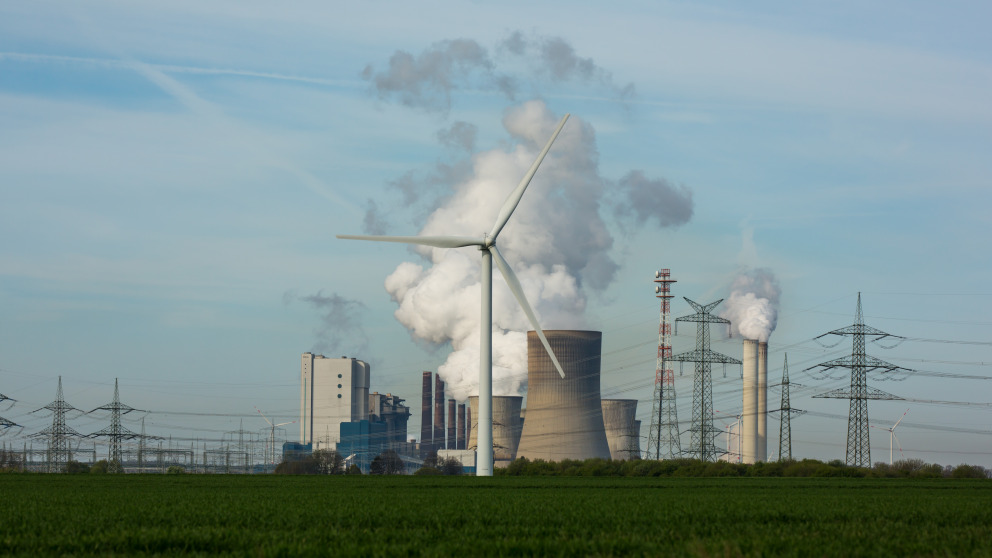Symptom of a Tipping Point Dynamic?
30.11.2021

Without a doubt, the COP26’s coal commitment was a major disappointment. The “phase-out” was made a “phase-down”, which is salt in the eyes of many given the massive consequences global warming is already having. However, and many commentators agree on this (Abnett and Volcovici 2021, Jotzo 2021), the resolution does send a clear signal. The writing is on the wall – a new narrative has begun that foresees an end to coal in the medium to long term.
Yet it is also possible that the resolution, as weak as it sounds, is the symptom of a tipping point: The fossil energy regime is already in an unstable state, so a signal that is considered insignificant can already have a major impact. This mechanism, known primarily from biophysical science (Lenton et al 2019), is getting more and more attention in social transformation research (IASS 2021). A social tipping point is the moment when the trajectory of a social system sees a minor shift which triggers a non-linear and abrupt change. This change rapidly leads to a possibly irreversible systemic transformation through self-reinforcing processes. A decisive factor for social tipping points is the purposeful action of actors – in other words, conscious action that can influence one's own environment on various temporal and spatial levels.
Examples can be found in many areas. German reunification was undoubtedly such a systemic upheaval, accompanied by large population loss and an almost complete economic collapse in the East German states. Another example is Germany’s introduction of the Renewable Energy Sources Act in 2001. The act was a trivial national policy intervention at the time, but it sparked the comprehensive development of solar and wind energy. This, in turn, was followed by a learning effect which led to tremendous cost reductions, making renewable energies attractive for other countries. A global self-reinforcing cycle of market growth and cost reduction was the result. The impact of these developments could only be understood in retrospect.
By all accounts, the coal industry is also subject to self-reinforcing feedback, and tipping points can already be identified in certain countries and sectors. For instance, who would have thought four years ago that the conservative Polish government would consider a coal exit (Lesser 2020). Up to now, coal has played a leading role in gross energy consumption in Poland, accounting for 46 per cent. However, in addition to the fact that all coal mines in the country are running at a loss, the massive health impacts (EEA 2021) of coal combustion are putting increasing pressure on policymakers (Lesser 2020). In the Polish Energy Policy 2040, the Polish government has promised a nearly new power system with a strong base of low- and zero-emission sources. Coal burning in urban households is to be ended by 2030, and all mines are set to be closed by 2049 (Ministerstwo Klimatu i Srodowiska 2021) to meet the EU climate targets by 2050.
The hard-won compromise in 2020 to phase out coal-based power generation and lignite mining in Germany by 2038 was undoubtedly a tipping point (BMWi 2020). The process is now gaining momentum. The coalition agreement just adopted by the new German government provides for an end to coal by 2030 so that Germany can achieve its climate targets (SPD Website 2021).
Such tipping points can also be seen in other European countries. Portugal shut down its last remaining coal power plant a week after the conclusion of COP26 (Euronews), making it the fourth country in the European Union to do so (Table 1). Within the EU, existing coal power plants are being decommissioned at a faster rate, with 56 per cent either already closed since 2010 or scheduled for closure by 2030. Not only that, the pipeline of proposed coal power plants in OECD and EU countries has fallen a dramatic 85 per cent over the past six years (E3G 2021).
Table 1: Coal phase-out dates in EU countries
|
Date of exit |
Countries |
|
Coal exit already completed |
Belgium (2016) Austria (2020) Sweden (2020) Portugal (2021) |
|
By 2025 |
France (2022) United Kingdom (2024) Hungary (2025) Italy (2025) Ireland (2025) Greece (2025) |
|
By 2030 |
North Macedonia (2027) Denmark (2028) Finland (2029) Netherlands (2029) Slovakia (2030) Spain (2030) Germany (2030) |
|
By 2050 |
Romania (2032) Montenegro (2035) Poland (2049) |
Even China has realised that coal has no future. Despite watering down the COP26 resolution, China has stated that it will not build or support any new coal plants in other countries (Early 2021 and NewsCN 2021).
The financing of the coal industry is an important factor. As the Ruhr region witnessed, the last step can happen quite quickly. Here, too, momentum accelerated after a political majority turned away from permanent coal subsidies. But it is not just governments who are turning their backs on coal: Globally, over 130 financial institutions have announced that they will no longer finance, invest in, or insure coal (Institute for Energy Economics and Financial Analysis [IEEFA]), 2020) (Briggs and Mey 2020).
The COP26 coal decision might not have been a huge success, but it does join a cascade of events suggesting tipping points that will put an end to coal in the short to medium term.
